The Mercedes EQE Is a Better Package Than Its Gas E-Class Counterpart
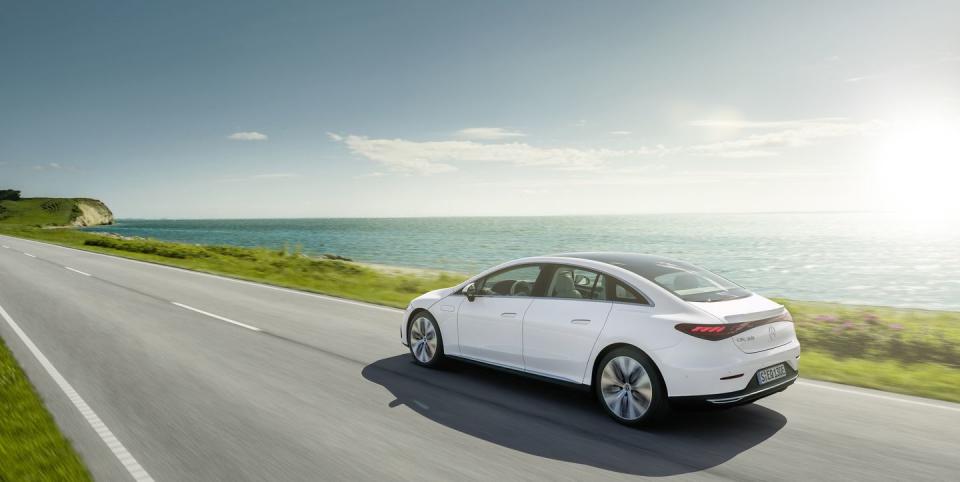
Sedan fans know, sometimes to their chagrin, that SUVs are winning the popularity contest. Yet we tend to overlook how the Tesla Model S and Model 3—both sedans, last I checked—broke ground, broke through, and built a near-fanatical following around the globe.
So it can be done. And if any sedan has a prayer of building a new audience, it probably has to be electric. The Mercedes EQE could be that kind of car, with brisk performance, a rich-and-techy interior, and a reasonable driving range, for far less money than the EQS flagship sedan. It might help if the EQE looked better: More recognizably Benzian, less hybrid-y, and utilitarian. But perhaps people don’t really want, say, a traditional E-Class where the “E” stands for electric. Time will tell if Mercedes is on the right track, by clearly demarcating its new EQ model range—and ideally, evolving those designs into more-distinctive shapes. A forthcoming EQE SUV, easily the most handsome EQ yet, offers tangible evidence that Mercedes is on the case.
For now, the 2023 EQE is Mercedes’ mid-length electric sausage, extruded largely from the same machine that produces the larger EQS. For sedan enthusiasts, the good news is that some things never change: The EQE is smaller, (relatively) lighter, and nimbler than the EQS. In modern Mercedes fashion, the EQE offers virtually every luxury hand-me-down from its big Bruder, from a 56-inch Hyperscreen to a finely tuned air suspension and two choices in rear-axle steering (all optional).
Like the EQS, the EQE is one of the quietest sedans I’ve driven, and I mean Rolls-or-Bentley quiet. Every surface has been smoothed or improved—flush-mounted wheels, roof pillars, panoramic sunroof, underbody panels, door and window seals—to repel the wind noise that becomes more noticeable and intrusive in an EV. Electric motors themselves are engineered for maximum silence, then swaddled in foam mats and decoupled from the body via subframes and elastomeric bearings.
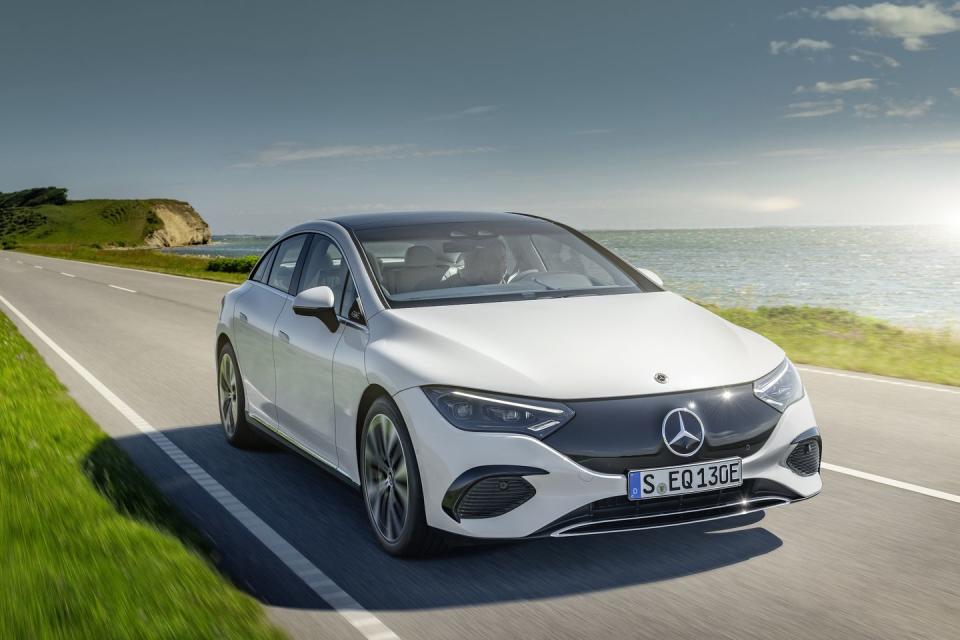
Despite three German-built versions bound for showrooms by late fall, Mercedes still hasn’t revealed the price. But we estimate the base model, rear-drive EQE Plus will start from around $72,000, about $15,000 more than a fossil-fueled E 350, and about $25,000 less than an EQS.
That 350 Plus will hum to 60 mph in a reasonable 6.2 seconds, Mercedes says, countering a roughly 5400-pound curb weight with 288 hp and 391 lb-ft of immediate torque. A 350 Plus 4Matic adds a front electric motor that bumps torque to 564 lb-ft (with the same 288 horses), yet officially cuts just 0.2 seconds from the 0-60 run, to 6.0 seconds.
Keeping up with the electric Joneses may require an EQE 500 4Matic, with 402 hp and 633 lb-ft—134 fewer horses than BMW’s rip-snorting i4 M50i, but 95 additional pound-feet. Mercedes says it’s good for a 4.5-second jaunt to 60 mph. You’re also looking at a roughly $85,000 electric sedan, by our best estimate, and above $100,000 fully loaded. When Mercedes ships an even-pricier AMG EQE next year, with up to 677 hp and 738 lb-ft of torque, this sedan may not hunt in Tesla Plaid territory but will stuff and mount a variety of gasoline-powered prey.
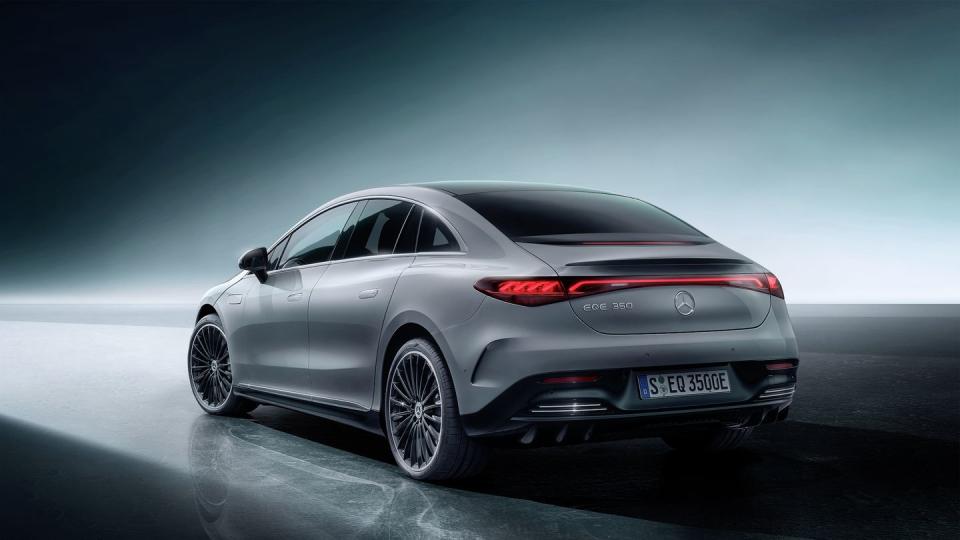
On an early-morning romp around Red Rocks Amphitheater in Colorado, the EQE 500 barreled through downhill esses with breathtaking pace. Steering is heftier than an EQS, even a bit feelsome by typically numb electric standards: Better than a Tesla or Audi e Tron, on par with an i4, still trailing the Porsche Taycan gold standard. The optional air suspension slathers cream over the road surface, and 10-degree rear-axle steering (with a lesser 4.5-degree system available) cuts the turning circle to a tidy 35 feet. Adaptive dampers afford tauter control versus an EQS that’s nearly 11 inches longer, on a 3.6-inch longer wheelbase. For all its pace and rock-solid confidence, the EQE won’t be putting, say, a Mercedes-AMG E 63 out to pasture. Like some other powerful EVs, the EQE has a connect-the-dots feel: Aim for a distant corner, arrive sooner than expected, rein in that multi-ton mass, then blast off again like a Space Camper. A shortage of old-school engagement is exacerbated by the EQE’s blended brake pedal; a smushy, non-linear cipher that’s best left untouched in favor of regenerative stops at selectable strengths.
A pair of digital “soundscapes,” Silver Waves and Vivid Flux, add a synthesized hum to the proceedings, with the more-bumptious Roaring Pulse available via an OTA update.
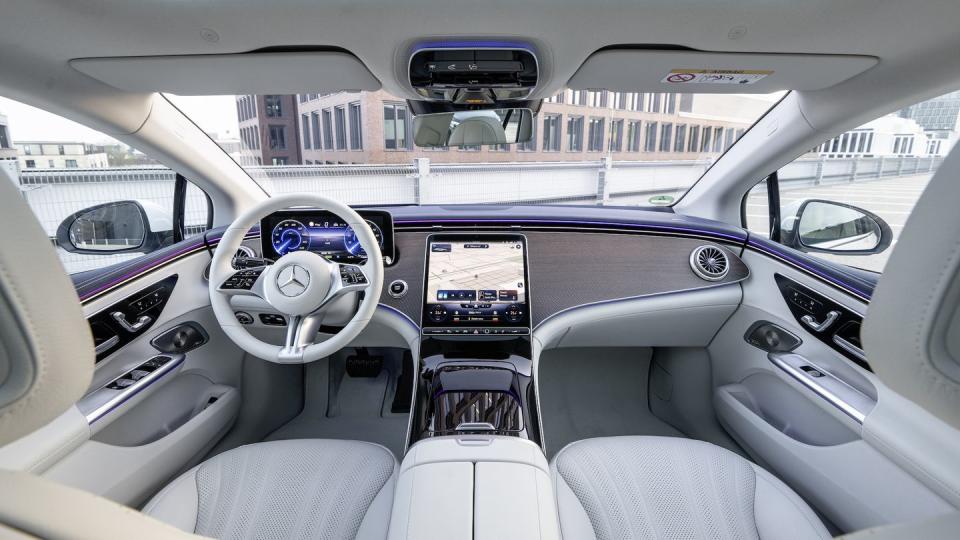
Dimensionally, this EQE sits roughly atop a CLS-Class, with a traditional trunk versus the glassed-in hatch of the EQS. It squeezes 10 of the EQS’ 12 battery modules into its skateboard architecture, for a 90.6 kWh total. Charging maxes out at 170 kW, versus the 250 kW or more of some competing models. But Mercedes says forget the peaks: The EQE can sustain a roughly 160-kW average through much of a fill-up, and go from 10 to 80 percent full in about 31 minutes. Driving ranges aren’t official, but the Mercedes won’t be setting any records: Expect right around 300 miles for EQE 350 models, and perhaps 260 or 270 miles for the powerful EQE 500.
With functional aero already about as slippery as it can get, Mercedes’ dramatically more efficient, next-gen electric powertrains can’t get here soon enough.
Unlike the flagship battle of EQS-vs.-S-Class, the EQE’s electric packaging measures up better. Versus an E-Class, there’s one inch more shoulder space front or rear, and Mercedes cites more than two inches of added legroom in back. But Mercedes’ claim that the EQE loses just 0.2 inches of headroom versus E-Class isn’t borne out in practice. For one, EQE back-seat riders sit 2.5 inches higher, putting their heads in the rafters. As with the EQS, the combination of a tall cowl with a short windshield and stingy side-and-rear glass plays hell with outward visibility—especially to the rear, whose sightlines feel more supercar than sedan. Rear seat ingress and egress are also hindered by the signature, arching “one bow” roof, which requires a polite, Japanese-style head bow to duck below.
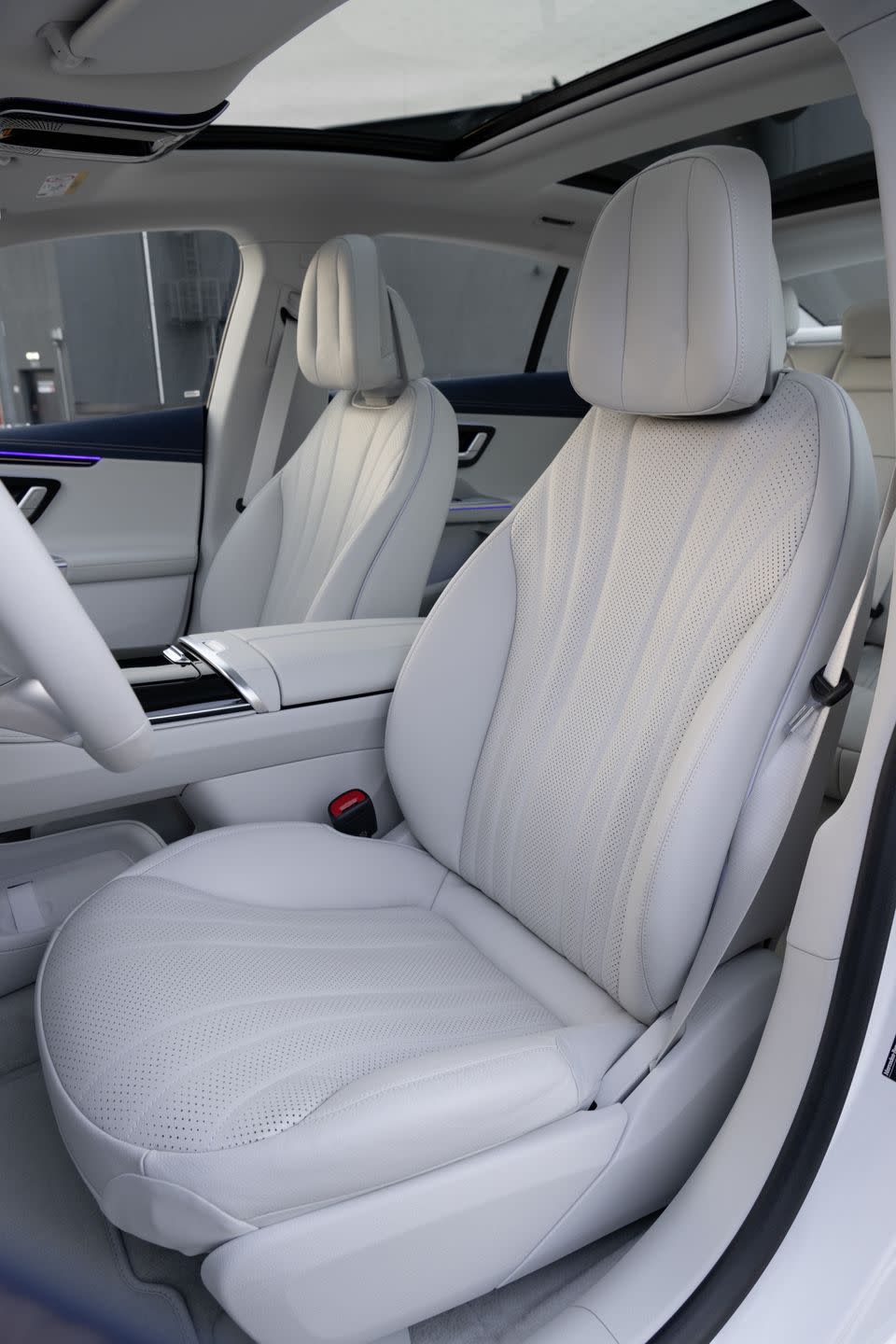
To the good, the EQE brings near-flagship levels of visual and digital luxury, from beautiful rose-gold metal accents and sculpted turbine-style vents to the Hyperscreen, Burmester audio, and a dizzying array of driver-assistance systems. The latter includes adaptive cruise control that can adjust to prevailing speed limits, active steering for lane keeping and lane changes, evasive steering maneuvers, and more. There’s facial recognition for various functions, biometric authentication, and for maximum decadence with zero calories, an exclusive MOOD No. 6 interior fragrance inspired by dark chocolate. An improved “Hey, Mercedes” voice assistant is fluent in 27 languages and can learn to recognize individual occupant voices to access personal data and profiles.
The Hyperscreen flashes its leading-edge animations and graphics on a conjoined 12.3-inch driver’s cluster and OLED, haptic 17.7-inch touchscreen and 12.3-inch passenger screen. Those displays are directly bonded to a complex, hot-molded curved glass that’s especially easy to clean, and adjust their brightness automatically based on ambient conditions. It’s like being on the set of Spielberg’s Ready Player One, or inside the GGI computers that created it. With more than 100 interior LEDs, active ambient lighting can become part of the show, with animated presentations or mood-setters for Energizing Comfort programs. The system can also flash alerts tied to driver assistance systems. The driver’s screen does bring one ergonomic hiccup, set so high that its digital speedometer was blocked by the steering wheel, forcing me to tilt the wheel higher than I prefer. For a more-traditional experience, with no great loss in functionality, the EQE offers a standard, tablet-style center screen. That opens an expanse of dashboard for the rich wood (or gloss black) that befits a Benz sedan, including the strikingly rippled, open-pore wood of my test car.
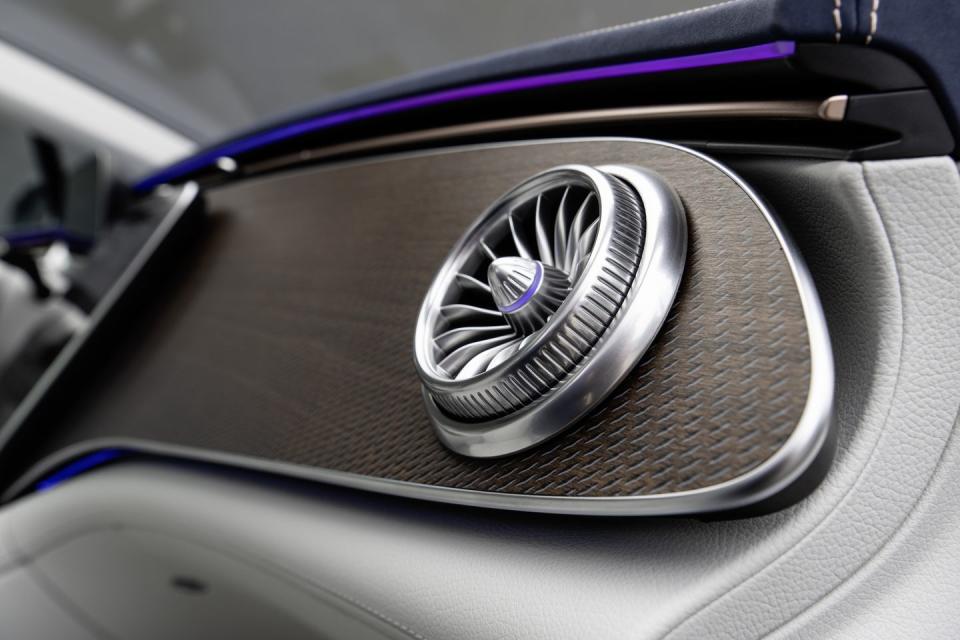
It’s all part of a new plug-in world for Mercedes and its legion of well-heeled fans. The brand insists it’s preparing to go fully electric by the end of the decade, with one big disclaimer of “wherever market conditions permit.” That said, Mercedes is readying three new electric architectures and promises that every new platform from 2025 forward will be electric only.
The EQE is an intriguing harbinger of that future, with demonstrable advantages over its ICE-fueled brethren; but kinks to iron out, including shorter range and slower acceleration than Silicon Valley rivals. For the foreseeable future, models like the EQE also cost much more than even the sticker-shocking Mercedes we’ve come to know. We’re about to see how Americans, and our market conditions, adjust to all that.
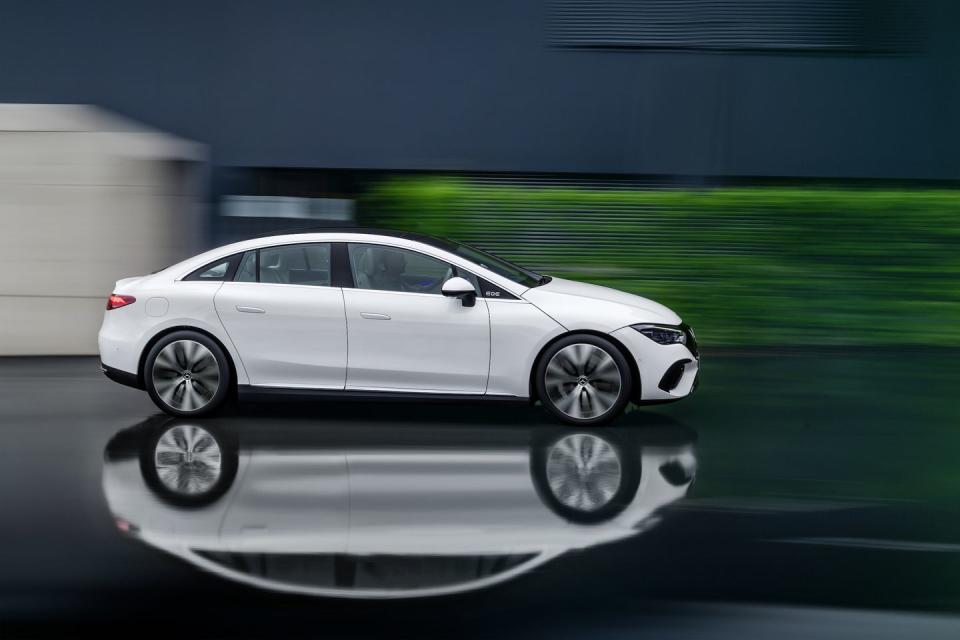
You Might Also Like

 Yahoo Autos
Yahoo Autos 